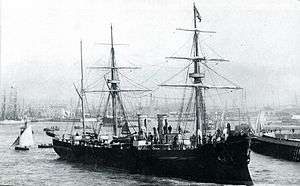Japanese cruiser Unebi
 Unebi departing Le Havre, France 1886 | |
| History | |
|---|---|
| Name: | Unebi |
| Ordered: | 1883 Fiscal Year |
| Builder: | Forges et Chantiers de la Gironde, France |
| Laid down: | 17 May 1884 |
| Launched: | 6 April 1886 |
| Completed: | October 1886 |
| Struck: | 19 October 1887 |
| Fate: | Disappeared December 1886 |
| General characteristics | |
| Type: | Protected cruiser |
| Displacement: | 3,615 long tons (3,673 t) |
| Length: | 98 m (321 ft 6 in) w/l |
| Beam: | 13.1 m (43 ft 0 in) |
| Draught: | 5.72 m (18 ft 9 in) |
| Propulsion: | 2-shaft VTE, 9 boilers, 5,500 hp (4,100 kW), 700 tons coal |
| Speed: | 18.5 knots (21.3 mph; 34.3 km/h) |
| Complement: | 280-400 |
| Armament: |
|
| Armour: |
|
Unebi (畝傍) was a protected cruiser of the Imperial Japanese Navy, designed and built in France by Forges et Chantiers de la Gironde. Unebi was named after Mount Unebi in Nara prefecture, located near the ancient capital of Asuka. Per Meiji period State Shinto mythology, this mountain was home to Japan's first Emperor, Jimmu Tenno.
Background
During the period of increasing tension with the Empire of China prior to the First Sino-Japanese War, the development of the protected cruiser was of great interest to Japan because of its high speed, powerful armament, armour protection and relatively low cost, especially since the Imperial Japanese Navy lacked the resources at the time to purchase modern pre-dreadnought battleships necessary to counter the Chinese Beiyang Fleet.[1] During the tenure of Naval Minister Kawamura Sumiyoshi, three vessels were ordered: Naniwa and Takachiho from the Armstrong Whitworth shipyards in England, and (for political purposes), Unebi from the Forges et Chantiers de la Gironde yards of France.[2]
Design
Compared with the Naniwa-class cruisers, Unebi was a slightly older design, which included a full barque rigging with three masts for auxiliary sail propulsion. The design utilised a relatively small displacement in a narrow hull with a disproportionately huge amount of armament.
Service record
Just three months after commissioning, in December 1886, en route from France to Japan with a French captain, Unebi disappeared without a trace somewhere in the South China Sea between Singapore and Yokohama. No survivors and no wreckage were ever found, and theories on its mysterious disappearance have led to numerous novels and works of speculative fiction; the prevailing theory was that the design was top-heavy due to its excessive armament and was unstable in rough weather.[3]
Unebi was officially declared lost with all hands and stricken from the navy list on 19 October 1887. Unebi is the only case of a ship vanishing without a trace in the annals of the Imperial Japanese Navy. A memorial monument to the missing crew of Unebi is located at Aoyama Cemetery in Tokyo.
The Japanese government cancelled the production of a second vessel per the same design, and received compensation from the French government. The monies went towards production of the cruiser Chiyoda. However, the Imperial Japanese Navy was reluctant to continue working with French shipyards after the Unebi disaster, and placed its order for the French-designed Chiyoda with John Brown & Company in Scotland.
Gallery
 Unebi in artwork
Unebi in artwork Underway, shortly after departing Le Havre
Underway, shortly after departing Le Havre At Le Havre, 1886
At Le Havre, 1886
Notes
References
- Evans, David C.; Peattie, Mark R. (1997). Kaigun: Strategy, Tactics, and Technology in the Imperial Japanese Navy, 1887-1941. Annapolis, MD: Naval Institute Press. ISBN 0-87021-192-7.
- Chesneau, Roger (1979). Conway's All the World's Fighting Ships, 1860–1905. Conway Maritime Press. ISBN 0-85177-133-5.
- Howarth, Stephen (1983). The Fighting Ships of the Rising Sun: The Drama of the Imperial Japanese Navy, 1895-1945. Atheneum. ISBN 0-689-11402-8.
- Jentsura, Hansgeorg (1976). Warships of the Imperial Japanese Navy, 1869-1945. Annapolis, MD: Naval Institute Press. ISBN 0-87021-893-X.
- Roberts, John (ed). (1983). 'Warships of the world from 1860 to 1905 - Volume 2: United States, Japan and Russia. Bernard & Graefe Verlag, Koblenz. ISBN 3-7637-5403-2.
- Roksund, Arne (2007). The Jeune École: The Strategy of the Weak. Leiden: Brill. ISBN 978-90-04-15723-1.
- Schencking, J. Charles (2005). Making Waves: Politics, Propaganda, And The Emergence Of The Imperial Japanese Navy, 1868-1922. Stanford University Press. ISBN 0-8047-4977-9.
External links
| Wikimedia Commons has media related to Unebi (ship, 1886). |